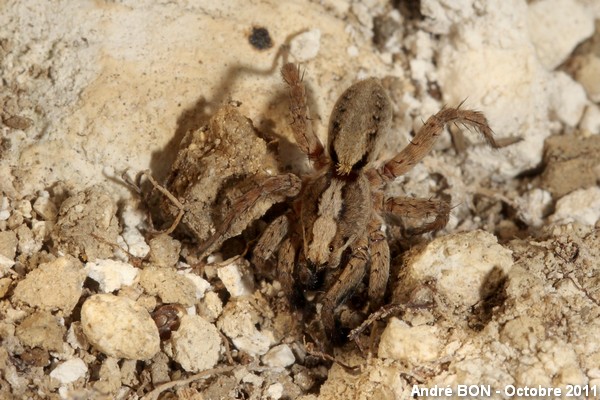
| Dune Wolf-spider (Xerolycosa miniata (C. L. Koch, 1834)) |

|
|
Scientific name: Xerolycosa miniata (C. L. Koch, 1834) Common name: Dune Wolf-spider French name: Order: Araneae Family: Lycosidae Size: 5 to 7.6 mm for females, 4,7 to 5.5 mm for males. Biotope: Sandy areas with short grass, missing in forests and in mountains. Web: No web Observation period: Adults appear in spring. Male are observed till mid-summer, females till late summer. Geographic area: Palaearctic region, including northern areas. |
You can tell the wolf spiders of the Xerolycosa genus apart with the broad light-coloured band on the cephalothorax, with the white line starting to circle the cephalothorax from the back and fading away before reaching the front. The tarsi show four long sensory setae or trichobothria. The pubescence on the legs, on the cephalothorax and on the abdomen provide a velvet-like look. The shape of the light-coloured band on the cephalothorax may help to tell the Dune Wolf-spider (Xerolycosa miniata) apart from the Burnt Wolf-spider (Xerolycosa nemoralis). This band is almost a constant width with parallel edges on which you can sometimes distinguish four small perpendicular points on Xerolycosa nemoralis. The edges are less straight on Xerolycosa miniata. You can see a narrowing at the back of the eyes with longer points oriented backwards. These points sometimes continue with a thin V-shaped mark, or even with a larger black mark in the middle of the light-coloured band. Furthermore there is another narrowing of the light-coloured band on the cephalothorax near the abdomen. There can be some kind of a small narrowing on Xerolycosa nemoralis but it appears as a slight progressive decrease of the distance between two straight edges. Notice that it is not always possible to tell Xerolycosa miniata apart from Xerolycosa nemoralis on photo. There is also a possible confusion with Pardosa lugubris and with some spiders of the Alopecosa genus like Alopecosa pulverulenta. Female Pardosa lugubris shows well ringed legs with hairs raised perpendicularly. The wolf spiders of the Alopecosa genus differ by the pattern on the upper side of the abdomen. |
| [To know more about the Dune Wolf-spider] [Top] |

|
I have photographed this wolf spider on the edge of a calcareous meadow with short grass. You cannot clearly see the cephalothorax's border. However this spider seems to match the Xerolycosa genus. The hairs on the tibia are not perpendicularly raised as on spiders of the Pardosa genus. The pattern on the abdomen does not seem to match one spider of the Alopecosa genus. The broad band on the cephalothorax, with its narrowing, is typical of Xerolycosa miniata. |